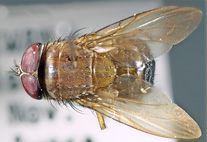Abstract
The Oriental, Australasian and Oceanian genus Caiusa Surcouf, 1920 is revised, species concepts being based on male and female genitalia. A key to males for all known species, and a key to females for all except one are given. All relevant types still in existence have been studied, complete synonymies given and the geographical distribution reconsidered. The eight species included in the genus are: Caiusa borneoensis sp. nov. (Malaysia, Thailand, Vietnam); Caiusa coomani Séguy, 1948 (China, Malaysia, Singapore, Thailand, Vietnam); Caiusa indica Surcouf, 1920 (Australia, Cambodia, India, Indonesia, Malaysia, Papua New Guinea, Philippines, Singapore, Solomon Islands, Sri Lanka, Thailand, Vietnam); Caiusa karrakerae sp. nov. (Malaysia, Thailand); Caiusa kurahashii sp. nov. (Indonesia, Japan, Philippines); Caiusa pooae sp. nov. (Thailand); Caiusa testacea Senior-White, 1923 (India, Nepal, Sri Lanka) and Caiusa violacea Séguy, 1925, stat. rev. (Cambodia, China, Laos, Malaysia, Taiwan, Thailand, Vietnam). A lectotype is designated for Caiusa indica to fix the interpretation of the name. Caiusa nigronitens Senior-White, 1923, syn. nov. and Caiusa surcoufi Bezzi, 1927, syn. nov. are established as junior synonyms of Caiusa indica. Caiusa violacea is correctly diagnosed and errors in the original description of the female holotype are pointed out. Caiusa dubiosa Villeneuve, 1927 is established as a junior synonym of C. violacea, syn. nov. Seven Caiusa species have been reared from the egg mass of various species of frogs. The reproductive mode of the eighth species, i.e., C. indica, is unknown. Five species, i.e., C. borneoensis, C. coomani, C. karrakerae, C. kurahashii and C. violacea have been reared from one or more of the foam nesting frog species Chiromantis nongkhorensis (Cochran, 1927), Polypedates leucomystax (Gravenhorst, 1927), Polypedates megacephalus Hallowell, 1861, Rhacophorus annamensis Smith, 1924, Rhacophorus dulitensis Boulenger, 1892, Rhacophorus kio Ohler & Delorme, 2005 and Rhacophorus owstoni (Stejneger, 1907) all belonging in the family Rhacophoridae in Anura. These five Caiusa species all have a specialised ovipositor tip, with small spine-like setae on the ST8 and the hypoproct, probably enabling the flies to oviposit on a foam nest with a hardened outer surface. They form a monophyletic group on account of these features of the ovipositor, unique in the Oestroidea. The sixth species, C. testacea, has been reared from a frog egg mass, the frog species being unknown. Its ovipositor structure is also unknown. The seventh species, C. pooae, has been reared once from the jelly-like egg mass of Feihyla hansenae (Cochran, 1927), also in Rhacophoridae. Caiusa pooae females do not have spine-like setae on the ovipositor, a fact correlated with the soft outer surface of the jelly-like egg mass on which a C. pooae female had oviposited. The extreme rarity of C. pooae oviposition on Feihyla hansenae egg masses may indicate that this fly perhaps has another, unknown, regular oviposition substrate. Caiusa pooae and C. indica make up a second monophyletic group within Caiusa. Caiusa indica, the most common and most widespread species of the genus, has an ovipositor structure similar to C. pooae. Its breeding substrate is unknown and it occurs both within and outside the distributional area of Rhacophoridae. Possibly both C. indica and C. pooae share a regular oviposition substrate that has still to be discovered. The holotype female of Plinthomyia emimelania Rondani, 1875 from Sarawak is established as a member of the genus Bengalia Robineau-Desvoidy, 1830, thus Plinthomyia Rondani, 1875 becomes a junior synonym of Bengalia Robineau-Desvoidy, 1830, syn. nov. It is removed from the synonymy of Phumosia Robineau-Desvoidy, 1830.

